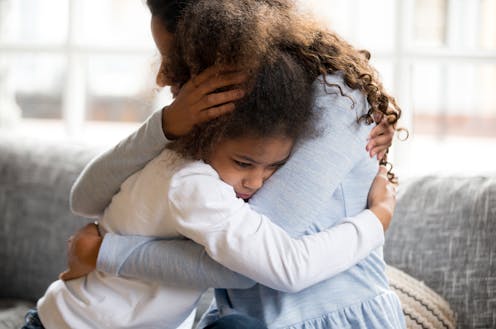
Anxiety rates have been rising in recent years among children and young people, with the situation partially exacerbated by the pandemic.
Occasional feelings of anxiety are normal, even in childhood – for example, a child may feel anxious about an approaching test at school. But if the anxiety is severe, long-lasting and interferes with a child’s daily life, it is called an anxiety disorder.
Our new research has found that the consequences of anxiety disorders in young people can include mental health issues in adulthood, lower grades at school and lower earnings.
But parents and doctors can find it difficult to distinguish everyday, age-appropriate fears and worries from anxiety problems that interfere with daily life.
Where families do seek support, they then struggle to access oversubscribed mental health services. Many children with anxiety disorders do not receive treatment. But our research shows that it is important for children with anxiety problems to receive timely treatment before they develop further.
Assessing research
We carried out a systematic review – a research project to identify, evaluate and synthesise all published research studies on a specific area of interest.
By examining the findings of this range of research studies, we found that people suffering from anxiety problems in childhood or as teenagers are more likely to have anxiety disorders in later youth and in adulthood. Numerous studies found a link between teenage anxiety disorders and adult depression.
We also found that teenagers who experience anxiety problems often miss more days of school and achieve lower grades than those who do not have an anxiety disorder.

One research study found that people aged 30 who had suffered anxiety disorders as teenagers were more than twice as likely to have been recently unemployed. They may also encounter difficulties in the workplace. This research shows that adults who had an anxiety disorder in childhood are more likely to struggle at work and to suffer with stress.
Unsurprisingly, all of this results in a considerable economic cost that affects children with anxiety themselves when they are adults, their families, and wider society. One study found that boys who suffered anxiety problems in childhood experienced 3% lower earnings from adult employment.
Research in the Netherlands published in 2008 found that parents paid an average of €96 out-of-pocket each year for their child’s treatment (equating to around £111 in the UK in 2023). Having a child with anxiety may also lead to their parents missing work. A study in the US published in 2020 found that the cost of these missed work days, per child, would cost society US$856 a year (equating to around £685 in the UK in 2023).
Helping an anxious child
Children typically rely on parents to seek help for them. Their anxiety may simply be part of growing up. However, if you note that the fears and worries of your child persist and start interfering with their daily activities and your family life, then it is wise to seek medical advice.
Our previous collaborative work showed that one way of helping children with anxiety disorders is to teach their parents how to use principles from cognitive behavioural therapy (CBT) when supporting their children. Parents worked through a self-help book and had sessions with a therapist.
We have found that this treatment is both clinically effective and good value for money. This treatment has been widely adopted by the NHS. Research on its use has also taken place in countries such as the US and Australia.
There is not much research evidence on the long-term effects of treatment of childhood anxiety, but the existing evidence suggests that treating childhood anxiety early and effectively could reduce the prevalence of adult mental health disorders. Given the global mental health crisis currently facing many countries – and their health systems – this possibility should not be ignored.
Mara Violato receives funding from the National Institute for Health and Care Research (NIHR) Programme Grants for Applied Research, Award Number: RP‐PG‐0218‐20010; the NIHR Oxford Health Biomedical Research Centre; and the NIHR Applied Research Collaboration Oxford and Thames Valley. The views expressed are those of the author and not necessarily those of the NHS, NIHR or the Department of Health and Social Care.
Jack Pollard receives funding from the National Institute for Health and Care Research (NIHR) Programme Grants for Applied Research, Award Number: RP‐PG‐0218‐20010. The views expressed are those of the author and not necessarily those of the NHS, NIHR or the Department of Health and Social Care.
Tessa Reardon receives funding from the National Institute for Health and Care Research (NIHR) Programme Grants for Applied Research, Award Number: RP‐PG‐0218‐20010. The views expressed are those of the author and not necessarily those of the NHS, NIHR or the Department of Health and Social Care.
This article was originally published on The Conversation. Read the original article.







